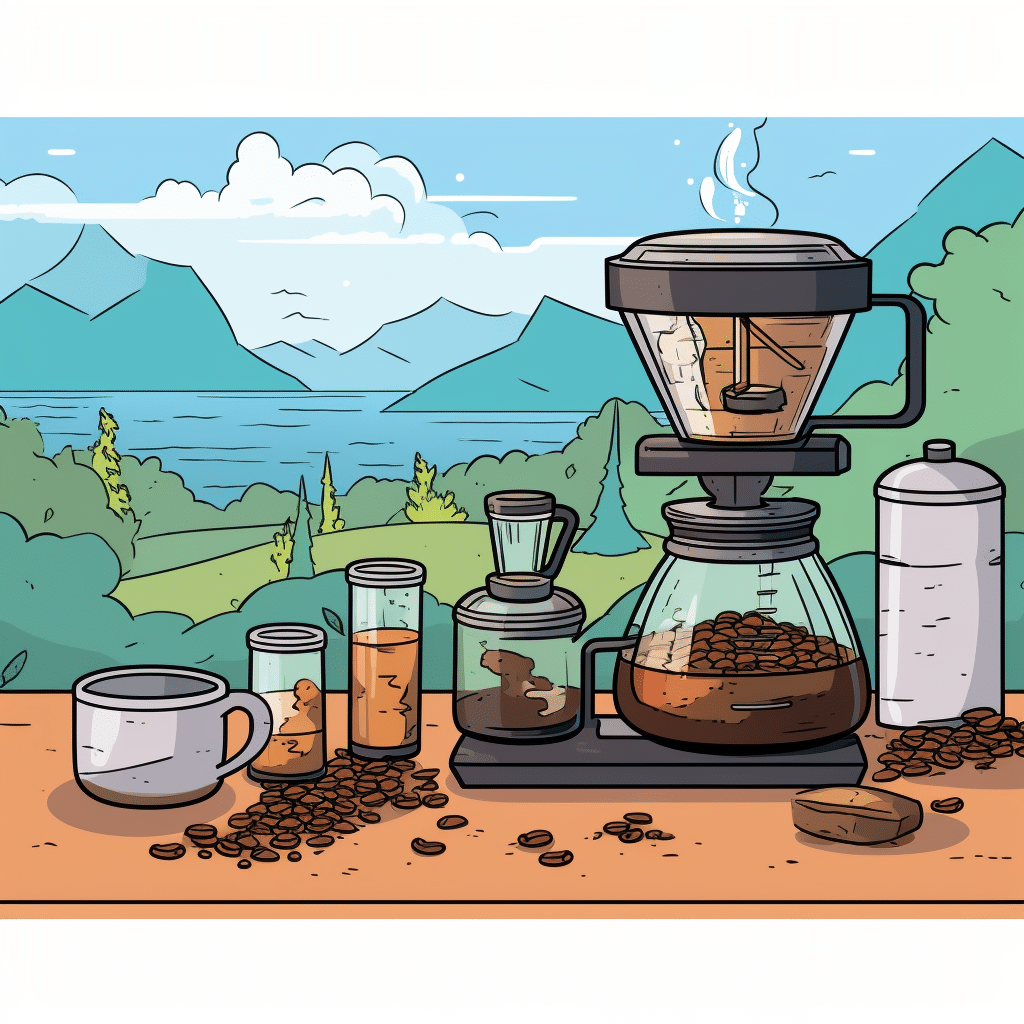Coffee brewing, a ritual savored by many across the globe, is much more than pouring hot water over ground coffee beans. It’s a complex process with significant environmental implications. From the cultivation of coffee plants to the moment a steaming cup is served, each step has environmental considerations that affect soil health, water resources, and overall ecosystem balance.

Large-scale coffee production often involves practices that can lead to deforestation, soil erosion, and water contamination. These issues not only affect the immediate surroundings but also have far-reaching consequences for global environmental health. Furthermore, coffee packaging and the energy consumed during brewing contribute to the footprint of every cup.
Key Takeaways
- Environmental impacts of coffee span from cultivation to consumption.
- Sustainable practices and consumer choices can mitigate coffee’s ecological footprint.
- Packaging and energy use in brewing present opportunities for reducing waste and emissions.
The Journey of Coffee Beans

The path that coffee beans take from farms to cups affects both the environment and the industry. This journey encompasses the methods of cultivation, the types and varieties of coffee produced, and the environmental consequences of these processes.
From Farm to Cup
Growing Regions: Coffee production starts with the farmers, primarily in countries like Brazil, which is the largest producer of coffee. The two main species of coffee, Arabica and Robusta, demand different growing conditions. Arabica beans prefer higher altitudes and milder temperatures, whereas Robusta beans thrive in hotter, harsher climates.
- Arabica Beans: Grown primarily in Latin American countries, they are favored for their sweeter, softer taste.
- Robusta Beans: These beans are cultivated in African and Asian regions, noted for their stronger, more bitter flavor profile.
Harvesting and Processing: After growth, coffee beans are harvested either by hand, selectively picking ripe beans, or through strip harvesting. They then undergo various methods of processing which can include drying in the sun or using water to separate the beans from the pulp.
Environmental Impact of Coffee Production
Deforestation and Biodiversity: Coffee farming can lead to deforestation as forests are cleared to make room for plantations. This not only contributes to emissions but also to biodiversity loss. Shade-grown coffee is a response to this issue, where coffee is grown under the canopy of existing trees, thus maintaining habitat for wildlife.
- Shade-Grown Coffee: Preserves natural ecosystems, providing home to birds and other fauna.
- Organic Farming: Utilizes natural methods to deter pests, avoiding harmful pesticides that can degrade the land and water sources.
Climate Change and Coffee: Coffee plants are sensitive to temperature changes, making them vulnerable to the effects of climate change. Extreme weather events, such as droughts or heavy rainfall, can damage crops, impacting both yield and quality.
Sustainable Practices: The coffee industry is increasingly focusing on reducing its environmental footprint through more sustainable practices. Innovations in coffee production include water conservation measures and exploring more eco-friendly processing techniques.
Coffee Brewing Techniques

A growing awareness of environmental impact has redefined the way we approach coffee brewing, challenging both individuals and industries to adopt methods that not only produce a great cup of coffee but also conserve resources and minimize pollution.
Conventional Brewing Methods
Conventional coffee brewing methods include a variety of techniques, each with its own environmental implications. The French Press, for instance, requires no paper filters, thus reducing waste, but it typically leaves behind a more considerable amount of coffee sediment, which can be a concern due to potential water contamination. The pour-over method provides a clean cup by using paper filters, but this increases waste unless compostable filters are used. Electric coffee makers, while convenient, consume a significant amount of energy during brewing.
Eco-Friendly Brewing Innovations
In response to ecological concerns, eco-friendly coffee brewing methods are becoming more prevalent. The AeroPress is a popular device due to its efficient use of coffee grounds and minimal energy requirement, which aligns with sustainable coffee principles. Innovations in this space often focus on reducing energy consumption with some machines now being powered by renewable energy. Avoiding single-use plastics and utilizing technology that conserves water and energy are at the heart of these advancements. Moreover, eco-friendly practices include the use of biodegradable materials in the manufacturing of coffee brewers and accessories, further diminishing environmental footprints.
Impact of Coffee Consumption

The global passion for coffee has significant environmental implications, from the waste generated by single-use coffee pods to the carbon footprint of brewing methods. Consumers’ choices can heavily influence these impacts, making it essential to consider sustainable habits.
Home versus Commercial Consumption
Home coffee brewing offers the chance to control one’s environmental impact directly. For instance, one can opt to use reusable coffee filters instead of single-use coffee pods, which greatly reduces waste. It’s estimated that billions of coffee pods end up in landfills annually, making the choice of reusable options not just friendlier for the wallet but also for the planet.
Coffee shops and restaurants, on the other hand, often rely on the efficiency of single-use containers and utensils. However, the shift towards sustainability is noticeable as many commercial establishments now encourage customers to bring their own cups and even offer discounts as incentives.
Consumer Habits and Sustainability
The individual’s role in coffee consumption habits is crucial. Whether it’s choosing a hand-poured brew over an espresso or opting for fair trade and organic beans, these decisions can help reduce the carbon footprint and greenhouse gas emissions associated with coffee production and consumption. Here’s a breakdown of habits that can be tweaked for sustainability:
- Coffee preparation: Choosing manual brewing methods like French press over electric coffee machines to save on energy.
- Type of coffee: Buying coffee that’s certified as sustainable can ensure better farming practices that are less harmful to the environment.
- End-of-life for products: Composting coffee grounds and recycling or upcycling the packaging materials helps minimize waste.
By adopting eco-friendly practices and being conscious of their human behavior in relation to coffee consumption, individuals can significantly reduce their environmental footprint.
Sustainable Business Practices

In the coffee industry, sustainable business practices are essential for reducing environmental impact and promoting social equity. Companies have a crucial role in implementing measures that lead to a more sustainable future.
Corporate Responsibility
Businesses in the coffee sector are increasingly recognizing their responsibility to the environment and society. They adopt corporate sustainability strategies that minimize greenhouse gas emissions and promote ethical labor practices. For instance, a fair trade certification holds companies accountable for paying farmers fair wages and ensuring safe working conditions. This not only supports the communities involved in coffee production but also provides transparency to consumers.
Pathways to Sustainability in Coffee
Shifting toward sustainable coffee involves a multifaceted approach. The reduction of carbon dioxide emissions through sustainable farming methods is a critical step. Coffee companies are exploring various practices such as:
- Renewable Energy: Utilizing solar or wind power in coffee processing reduces reliance on fossil fuels.
- Waste Management: Implementing systems to reduce, reuse, and recycle waste materials from coffee production.
- Organic Farming: Avoiding synthetic pesticides and fertilizers enhances soil health and biodiversity.
Adopting these practices not only contributes to sustainability but also can lead to better quality coffee.
Packaging and Waste Management

When considering the environmental impact of coffee brewing, it’s crucial to address both the innovations in coffee packaging and the effective management of coffee waste, including coffee grounds and single-serve pods.
Innovations in Coffee Packaging
In recent years, there has been a shift towards more environmentally friendly coffee packaging solutions. These include the use of biodegradable materials and recyclable components that aim to reduce plastic waste. Some companies have started using reusable containers that customers can refill, cutting down on single-use packaging. An increasing number of roasteries are also adopting fully recyclable coffee packaging to minimize their carbon footprint.
Recycling and Composting Coffee Waste
Recycling coffee waste, including coffee pods and grounds, has become a critical step in mitigating environmental impact. While the convenience of single-serve coffee pods is undeniable, they generate significant plastic waste. Efforts are underway to create recyclable and compostable pods. Coffee grounds, on the other hand, are being repurposed for garden compost or even as a medium for growing mushrooms. Consumers and businesses alike are encouraged to participate in programs that emphasize the recycling or composting of their coffee waste to prevent it from ending up in landfills.
Reducing Carbon Emissions

Minimizing carbon emissions in coffee production is crucial. Employing renewable energy sources and enhancing the efficiency of transportation and manufacturing processes are key strategies for a smaller carbon footprint.
Role of Renewable Energy
Renewable energy plays a pivotal role in reducing the environmental impact of coffee brewing. By transitioning to energy sources such as solar or wind power in coffee processing facilities, the industry can lower its dependence on fossil fuels. A life cycle assessment (LCA) of coffee production often reveals that energy used in brewing and processing stages significantly contributes to carbon emissions. By integrating solar panels or wind turbines, coffee producers can cut emissions and move towards a more sustainable model.
Reducing Emissions in Transportation and Manufacturing
The transportation of coffee beans from farms to consumers also has a measurable carbon footprint. Utilizing vehicles that run on biofuels or electric energy can lead to a substantial reduction in greenhouse gas emissions. Similarly, in the manufacturing process, companies can invest in energy-efficient machinery and optimize logistics to minimize the distance products travel, further reducing emissions. These changes, combined with a robust LCA, can ensure that coffee production is environmentally responsible.
Consumer Choices and Environmental Impact

When it comes to brewing coffee, the choices consumers make can have a significant impact on the environment. From purchasing eco-friendly products to embracing the use of reusables, every step in the coffee consumption process can contribute to sustainability efforts.
Selecting Sustainable Products
Consumers can make a positive environmental impact by choosing eco-certified coffee. Brands that prioritize fair trade and ecological certifications ensure that their coffee is produced with sustainable practices. By choosing brands that support sustainable farming, individuals can help reduce the environmental impact of coffee production. Additionally, opting for a reusable filter over single-use paper filters can cut down on waste. A study mentioned by the Washington Post suggests that single-use coffee pods might produce fewer greenhouse gas emissions than some traditional brewing methods, offering a different perspective on the sustainability of coffee consumption.
The Move Towards Reusables
There is also a growing trend in the coffee-drinking community towards using reusables to minimize waste. Reusable coffee cups and mugs have become more common as consumers seek to reduce their single-use waste. Furthermore, using a reusable filter for brewing coffee, such as a metal or cloth filter, offers an alternative that eliminates the need for disposable paper filters, thus lessening the environmental footprint. For individuals who use single-use coffee pods, the market now includes options for recycling the pods or purchasing reusable coffee pod versions to further decrease waste.
Trends in Coffee and Sustainability

The coffee industry has seen a considerable shift toward sustainable practices in recent years, with a clear focus on minimizing environmental impacts and improving the coffee supply chain.
Shifting Industry Dynamics
The coffee sector is increasingly emphasizing sustainability trends, recognizing the significant impact that traditional methods have had on the environment. They are moving away from synthetic fertilizers due to their detrimental effects on ecosystems. Instead, organic farming practices are being adopted, utilizing natural compost and reducing the reliance on chemicals. As consumer awareness grows, demand for sustainable coffee products is driving the industry to prioritize these ecologically sound practices throughout the supply chain.
Influence of Technological Advancements
Technological advancements are playing a pivotal role in enhancing sustainability in the coffee industry. Precision agriculture tools are allowing farmers to use resources more efficiently, leading to less waste and lower inputs of water and fertilizers. New technology also aids in coffee bean processing and packaging, with innovations that aim to reduce energy consumption and carbon footprints. Furthermore, blockchain technology is improving traceability in the supply chain, ensuring transparency and promoting sustainable sourcing practices.









